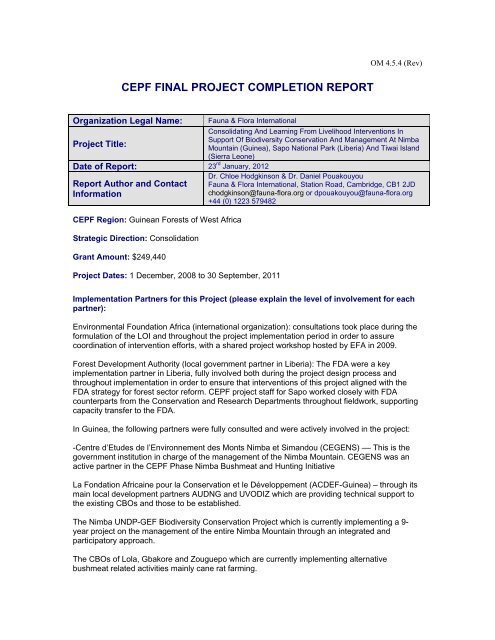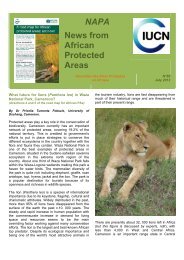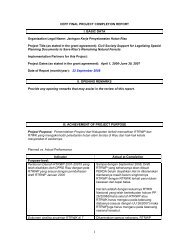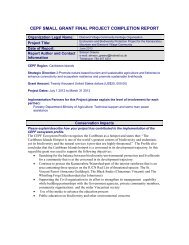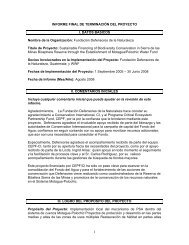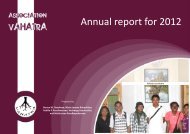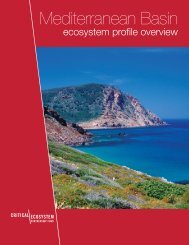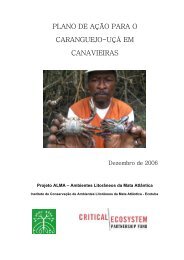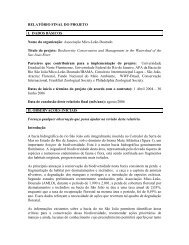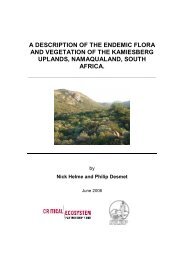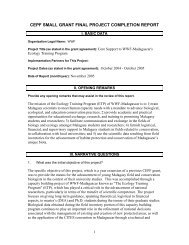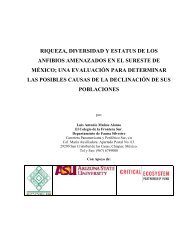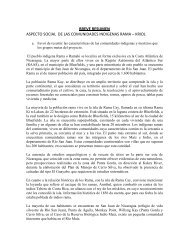English - Critical Ecosystem Partnership Fund
English - Critical Ecosystem Partnership Fund
English - Critical Ecosystem Partnership Fund
Create successful ePaper yourself
Turn your PDF publications into a flip-book with our unique Google optimized e-Paper software.
CEPF FINAL PROJECT COMPLETION REPORT<br />
OM 4.5.4 (Rev)<br />
Organization Legal Name: Fauna & Flora International<br />
Consolidating And Learning From Livelihood Interventions In<br />
Project Title:<br />
Support Of Biodiversity Conservation And Management At Nimba<br />
Mountain (Guinea), Sapo National Park (Liberia) And Tiwai Island<br />
(Sierra Leone)<br />
Date of Report: 23 rd January, 2012<br />
Report Author and Contact<br />
Dr. Chloe Hodgkinson & Dr. Daniel Pouakouyou<br />
Fauna & Flora International, Station Road, Cambridge, CB1 2JD<br />
Information<br />
chodgkinson@fauna-flora.org or dpouakouyou@fauna-flora.org<br />
+44 (0) 1223 579482<br />
CEPF Region: Guinean Forests of West Africa<br />
Strategic Direction: Consolidation<br />
Grant Amount: $249,440<br />
Project Dates: 1 December, 2008 to 30 September, 2011<br />
Implementation Partners for this Project (please explain the level of involvement for each<br />
partner):<br />
Environmental Foundation Africa (international organization): consultations took place during the<br />
formulation of the LOI and throughout the project implementation period in order to assure<br />
coordination of intervention efforts, with a shared project workshop hosted by EFA in 2009.<br />
Forest Development Authority (local government partner in Liberia): The FDA were a key<br />
implementation partner in Liberia, fully involved both during the project design process and<br />
throughout implementation in order to ensure that interventions of this project aligned with the<br />
FDA strategy for forest sector reform. CEPF project staff for Sapo worked closely with FDA<br />
counterparts from the Conservation and Research Departments throughout fieldwork, supporting<br />
capacity transfer to the FDA.<br />
In Guinea, the following partners were fully consulted and were actively involved in the project:<br />
-Centre d’Etudes de l’Environnement des Monts Nimba et Simandou (CEGENS) –– This is the<br />
government institution in charge of the management of the Nimba Mountain. CEGENS was an<br />
active partner in the CEPF Phase Nimba Bushmeat and Hunting Initiative<br />
La Fondation Africaine pour la Conservation et le Développement (ACDEF-Guinea) – through its<br />
main local development partners AUDNG and UVODIZ which are providing technical support to<br />
the existing CBOs and those to be established.<br />
The Nimba UNDP-GEF Biodiversity Conservation Project which is currently implementing a 9year<br />
project on the management of the entire Nimba Mountain through an integrated and<br />
participatory approach.<br />
The CBOs of Lola, Gbakore and Zouguepo which are currently implementing alternative<br />
bushmeat related activities mainly cane rat farming.
Institut de Recherche et de Vulgarisation de l’Aulacodiculture en Guinée (IVRAG) –. The<br />
government institution in charge of cane rat farming in Guinea and which is providing the<br />
breeding stocks and start up supervision.<br />
The project also engaged with other ministerial departments such as the Ministry of Agriculture<br />
and the Ministry of Animal Husbandry at local level. Such local level engagement is important to<br />
catalyze technical support for the CBOs and will perhaps, in the long term, encourage<br />
government investments in post-project activities.<br />
Conservation Impacts<br />
Please explain/describe how your project has contributed to the implementation of the<br />
CEPF ecosystem profile.<br />
An important area in the implementation of the CEPF profile in the Upper Guinean Forest of the<br />
Guinean Forests of the West Africa Biodiversity Hotspot is the contribution to the alleviation of<br />
ecosystem degradation especially the effects of mineral extraction, hunting and overharvesting of<br />
biodiversity resources partly due to Limited Local Capacity for Conservation. This project<br />
specifically focused on the conservation of wildlife using an integrated approach that entailed<br />
understanding the dynamics of hunting in critical habitats and designing and implementing<br />
replicable alternative models to these practices. Unlike other initiatives where building the local<br />
conservation capacity usually consists in training and equipping government rangers especially in<br />
classical protected area management approach, the project has used a bottom up approach. In<br />
Liberia the project has established a clear understanding of the socio-economic drivers of the<br />
bushmeat trade in the southeast of Liberia and its integration into the local livelihood strategies,<br />
providing a sound basis for developing a relevant and sustainable approach to addressing<br />
overhunting in the area. In Nimba the project has worked with local hunters and the bushmeat<br />
traders to design and implement alternative source of proteins and income for all concerned. One<br />
of the most important achievements at Nimba is the establishment of baseline biological and<br />
socio-economic for long term impact monitoring. By tracking and follow trends in wildlife both at<br />
market and forest level, and also by ascertaining the impact of alternative livelihood investments<br />
on people’s wellbeing, it is possible to adjust and refine the strategy with time.<br />
Please summarize the overall results/impact of your project.<br />
A vastly improved understanding of temporal and spatial bushmeat hunting practices in and<br />
around Sapo national park has helped in the development of a bushmeat trade monitoring<br />
framework currently being implemented by the Forestry Development Authority, the mandated<br />
authority for this work in Liberia. FFI are continuing to work alongside the FDA to support both the<br />
long-term biomonitoring program and, to a lesser extent, the law-enforcement program,<br />
supporting future analysis of program efficacy.<br />
In Guinea, the project built on existing CBOs and drew the necessary lessons for consolidation<br />
and scaling up of the initiative to other important localities around the Nimba Mountains. In<br />
addition to constructing and equipping cane rat farming and fish farming facilities in the selected<br />
localities mainly Lola, Bossou, Gbakore, Zouguepo, N’Zoo and Tounkarata, the project has<br />
established and strengthened the capacity of the relevant CBOs to function dependently with<br />
minimal external support. Extending the investment to sustainable agriculture has helped to put in<br />
place a mechanism to reduce encroachment on wildlife habitats and maintain key ecological<br />
functions and processes on Nimba. Monitoring and assessing the key ecological and socioeconomic<br />
indicators will facilitate adaptive management for the long sustainable use of key<br />
resources in this key important biodiversity area of the Upper Guinean forest.
Planned Long-term Impacts - 3+ years (as stated in the approved proposal):<br />
Strengthened conservation and improved sustainable management of wildlife at Nimba and SNP<br />
through alternative source of proteins and income generating activities that are environmentally<br />
friendly, socially acceptable and financially sustainable.<br />
Actual Progress Toward Long-term Impacts at Completion:<br />
All too often, livelihood interventions are planned and implemented with no clear idea or<br />
structured assessment of the suitability of these options in terms of social acceptance and<br />
economic feasibility. This project directly addressed this issue in the Sapo National Park region<br />
by implementing a methodological, community-led approach to improving understanding of the<br />
potential for introducing well-researched livelihood activities as alternatives hunting for and trade<br />
in bushmeat at Sapo National Park. Whilst moving forward with the introduction of these<br />
proposed options was outside both the scope and resources of this project, this work will provide<br />
a solid empirical platform on which to develop locally relevant projects in the region with improved<br />
environmentally and economically sustainability, intended to directly contribute to the sustainable<br />
management of natural resources in the region.<br />
The project has led to the consolidation of the three initial CBOs in the Nimba region namely the<br />
Lola Women Bushmeat Sellers Association, the Hunters Association of Gbakore and Zouguepo<br />
and the Women Association of Bossou. These 3 CBOs are today almost autonomous, able to<br />
function effectively with limited external technical and financial support. The Lola Women<br />
Bushmeat Sellers Association in particular is the most prosperous in the locality with members<br />
able to install their own individual pig farms. The area where these women genuinely lack support<br />
is in veterinary medicine. The project is currently negotiating a long term arrangement with the<br />
relevant government department based in Lola so that adequate support is provided as required.<br />
The mandate of this government structure is theoretically to support animal husbandry<br />
investments across the region, but this is not always the case as the government budget is rarely<br />
available and when it is, only occasionally at the time when needed. Basically the project is<br />
working to establish a mechanism through which the local government chef veterinary officer can<br />
intervene and assist individual members or the entire group on animal health matters against a<br />
remuneration payment commensurate with the nature of the task and funded through the group<br />
or individual financial resource. In addition to the consolidation of the existing CBOs, the project<br />
has expanded geographically and thematically around the Nimba region. Other alternative<br />
protein-based CBOs were established and are now functional in the locality of N’Zoo and<br />
Tounkara. Exchange visits between the different groups are being promoted to facilitate local<br />
learning and experience sharing for the benefits of all concerned. Three other CBOs are<br />
supporting ecoagriculture in an attempt to stabilize farming and reducing the encroachment to the<br />
already seriously disturbed Nimba ecosystem. This initiative consists of training farmers in<br />
farming techniques including but not limited to composting using manure derived from pig farms.<br />
Alongside all these CBOs, the project has established an impact monitoring system for wildlife<br />
and people’s wellbeing.<br />
The wildlife monitoring system is carried out at two levels. The first level consists of collecting<br />
data on the amount of bushmeat entering the local market as well as the main species traded as<br />
the proxi indicators of the level of wildlife off take in the Nimba forest. The second level of<br />
monitoring is the classical forest-based monitoring system where direct and indirect sighting of<br />
wildlife species, especially those of conservation significance, are regularly monitored along<br />
permanent transects to inform on their relative abundance.<br />
Towards the end of the CEPF funding, the project developed and established a baseline<br />
monitoring system in pilot villages to ascertain the impact of the project investment on the rural
poverty. Key socio-economic indicators were selected and the current level in selected household<br />
ascertain for future change monitoring.<br />
Planned Short-term Impacts - 1 to 3 years (as stated in the approved proposal):<br />
i. Improved capacity of CBOs to manage alternative livelihood interventions in Nimba.<br />
ii. Improved understanding of temporal and spatial bushmeat hunting practices in and<br />
around Sapo National Park.<br />
iii. Sustainable alternative livelihood options identified for 3 communities around Sapo<br />
National Park<br />
Actual Progress Toward Short-term Impacts at Completion:<br />
i. Improved capacity of CBOs to manage alternative livelihood interventions in Nimba.<br />
The project phase under review started with the formulation of a strategic document that<br />
identified information needs, capacity needs, and subsequent action points for the<br />
consolidation and scaling up of animal-husbandry related livelihood activities as<br />
alternatives to bushmeat hunting and trade. A capacity building program was then<br />
developed with all concerned in order to strengthen the abilities of the CBOs to<br />
implement and manage animal husbandary<br />
All the CBOs around Nimba were assisted to develop bylaws and international rules and<br />
regulations setting out in unambiguous terms the aims and objectives of each group, the<br />
rights and obligations of each member and the group, and the rules governing the<br />
group’s functioning bearing in mind that the primary aim is the protection of the<br />
threatened wildlife on the Nimba Mountains. The legally binding instruments were all<br />
validated by the local administration in line with the current legislation in Guinea<br />
governing common initiative groups and the protection and management of wildlife<br />
especially in critical habitats such as the Nimba Mountains with conflicting land use<br />
practices and opportunities. A bank accounts operated by elected members were also<br />
opened for each group and all have been encouraged to use it as much as possible,<br />
either to deposit the group financial assets or to withdraw resources when needed for<br />
specific activities in line with the bylaws and international rules and regulations.<br />
Additional training was given to the members on how to carry out specific activities,<br />
especially with cane rat husbandry which is new to the region and the hunters not used to<br />
wild animals in the cages. The partnership established between the project and the<br />
IRVAG the government institution in charge of research and extension of cane rat<br />
farming proved to be extremely useful and specific members of the groups were training<br />
in specific aspects of facility management, feeding, healthcare of the animals, breeding<br />
strategy and crossing, etc. The experience gathered around the Guinea side of the<br />
Nimba Mountain was shared with the Liberians during exchange visits.<br />
The final but not the least important aspect of the project was the construction of key<br />
infrastructures such as additional cane rate facilities to increase the breeding capacity of<br />
the initiative. Two additional cane rat facilities were constructed and commissioned. Fish<br />
farming activities were also expanded to N’Zoo and Tounkarata two other localities in the<br />
Nimba region. So were also created a series of home gardens and community farms in<br />
Lola, Bossou, Tounkara and N'Zoo to diversify the income of the different group<br />
members and reduce their dependency on wild resource and encroachments on virgin<br />
lands especially around the core protection areas of the Nimba world heritage site.
ii. Improved understanding of temporal and spatial bushmeat hunting practices in<br />
and around Sapo National Park.<br />
This project conducted a 12 months study exploring the dynamics of bushmeat and trade<br />
in Sapo National Park. The study sought to better understand how people live within the<br />
rural setting around the national park and on what natural resources, bushmeat in<br />
particular, they depend. The study illustrated the extreme importance of bushmeat as<br />
both a source of protein and income to the communities that otherwise have very limited<br />
access to alternatives, such as domestic meat and fish. Household consumption studies<br />
revealed the influence of the agricultural cycles, taboos and market access on hunting<br />
and meat consumption patterns of park adjacent communities. Importantly, the work<br />
showed the economic value of hunting to both local and ‘outside’ hunters, with<br />
commercial hunters found to earn up to US$2000 per month in a country where the<br />
annual GDP per capita is $500. This project is assessing temporal bushmeat hunting<br />
practices through the development of a bushmeat trade monitoring framework developed<br />
and established. Practical guidelines were produced and shared with the FDA who are<br />
responsible for their implementation, although with continuing support from FFI.<br />
iii. Sustainable alternative livelihood options identified for 3 communities around<br />
Sapo National Park<br />
It was clear during the project design phase from the number of failed livelihood<br />
interventions around Sapo that very careful thought and focused research was needed to<br />
ensure suggested alternatives were culturally acceptably, economically feasible and<br />
environmentally sustainable. An initial regional seminar was organized and held on Tiwai<br />
Island (Sierra Leone) from the 16 th to the 18 th of November, 2009. This workshop brought<br />
together participants from Nimba (Guinea & Liberia), Sapo National Park and Tiwai Island<br />
communities with lessons exchanged on best-management-practices in alternative<br />
livelihood development in relation to bushmeat hunting and trade. Seminar proceedings<br />
were disseminated and emails have been regularly exchanged between seminar<br />
participants to assure continued exchange of best-management practices. A<br />
development specialist was subsequently engaged to further develop the road map for<br />
Sapo communities to maximise viability of subsequent interventions. The consultant<br />
studied the current situation in Sapo, identifying potential opportunities to diversify<br />
livelihoods to reduce reliance of bushmeat hunting and trade for communities living<br />
around Sapo National Park. Particular attention was paid to the lessons learned from<br />
previous interventions and data gathered during a recent study of the use of forest<br />
resources in Sapo communities. Within Sinoe County, Southeast Liberia, it has become<br />
clear that the development of any significant economic alternatives to bushmeat hunting<br />
are seriously limited by the lack of access to markets, prevented largely by the poor state<br />
of the roads and little communications infrastructure, including no mobile phone coverage<br />
in the area to connect producers and tradesman. This largely precludes the development<br />
of livelihoods based on products with short storage time, such as many agricultural<br />
products, without significant development of associated transport and communication<br />
infrastructure. A roadmap was produced for introducing the sustainable livelihood<br />
initiatives with the potential to be implemented under these conditions.<br />
Please provide the following information where relevant:<br />
Hectares Protected: In Guinea, ecological process have been gradually restored as hunting and<br />
trapping are significantly reduced in the cluster of 3 strictly protected areas of the Nimba<br />
Mountains Biosphere Reserve that include the Bossou Hill (320 ha), the Dere forest (8,920 ha)<br />
and the Guinea portion of the Nimba Mountain range that is World Heritage Site (12,540 ha).<br />
Hunting and trapping of threatened species also reduced in the transition zone (88,280 ha) and<br />
the buffer zone (35,140 ha)
Species Conserved: In both Liberia and Guinea, efforts were directed towards reducing hunting<br />
and trapping of threatened wildlife species especially the 16 species considered to high<br />
conservation importance locally and globally<br />
Corridors Created: None<br />
Describe the success or challenges of the project toward achieving its short-term and<br />
long-term impact objectives.<br />
This project has been extremely successful in achieving all of its short-term objectives. Whilst its<br />
achievements of the long-term impacts in Sapo National Park are not possible to assess within<br />
the implementation timeframe, the project is seen as an example of a pragmatic approach that<br />
strives to reconcile the double need of biodiversity conservation and improving rural livelihoods.<br />
In Nimba an important achievement of this project has been its ability to break barriers and<br />
facilitate dialogue among all the stakeholders along the wildlife hunting and bushmeat trade<br />
continuum. By openly and strategically offering to hunters and traders alternative options to the<br />
bushmeat business and helping them along the line on how to organize themselves and carry out<br />
their new activities in a productive and cost effective way, it is becoming less lucrative.<br />
The challenge obviously has been how to break barriers and build trust among all the<br />
stakeholders. Hunters in particular are a particularly difficult group of natural resource users not<br />
only in Guinea and Liberia, but perhaps throughout Africa and probably beyond. Bringing them<br />
into an open and transparent dialogue requires patience, perseverance and long term investment<br />
to bring about change in their behavior. An ongoing challenge remain to keep the trust build<br />
between them and the project for the double benefit of wildlife conservation and management and<br />
the improvement of the living standards of the local people. It is about change in attitude and with<br />
time, hunting for and trade in bushmeat will become a relatively marginal activity.<br />
Were there any unexpected impacts (positive or negative)?<br />
The project established baselines at the Nimba Mountains in Guinea for future change and<br />
impact monitoring in biological and socio-economic terms. This included the monitoring of the<br />
bushmeat trade in local markets, the monitoring of the relative abundance of wildlife species of<br />
conservation significance along permanent transects established in the wild and the assessment<br />
and monitoring of key indicators of poverty among the local communities directly or indirectly<br />
affected by the project. Monitoring data are being collected and it should be possible in a<br />
relatively short period of time of ascertain the trends in all the biological and socio-economic<br />
indicators for adaptive management.<br />
Project Components<br />
Project Components: Please report on results by project component. Reporting should<br />
reference specific products/deliverables from the approved project design and other relevant<br />
information.<br />
Component 1 Planned:<br />
Document successful interventions in pilot community-based organisations (CBOs) at the Nimba<br />
Mountain in Guinea, taking into account lessons learned from Tiwai, that focus on alternative<br />
livelihoods as an alternative to hunting for, and trade in, bushmeat in this region.<br />
Component 1 Actual at Completion:<br />
Using a combination of tools including SWOT analysis, the three initial CBOs at the Nimba<br />
Mountains in Guinea were comprehensively reviewed with the aim of drawing lessons and putting<br />
in place a strategy for scaling up the project geographically and thematically. The lessons drawn
including the preliminary knowledge on the process leading up to the establishment of these<br />
micro-enterprises were then compared and contrasted with the experience at Tiwai Island in<br />
Sierra Leone during the regional workshop that brought all the project stakeholders together<br />
including representative members from the Nimba CBOs.<br />
Component 2 Planned:<br />
Evaluate the knowledge gathered in Component 1 and develop a strategy for consolidating and<br />
scaling up to elsewhere around Nimba in Guinea and beyond into Sapo National Park (SNP) in<br />
Liberia.<br />
Component 2 Actual at Completion:<br />
The project formulated a strategic plan to consolidate existing activities at Nimba and built the<br />
capacity of the initial CBOs which are today almost completely autonomous with viable<br />
institutional arrangement including detailed bylaws and internal rules and regulations, financial<br />
management linked to a local bank, etc. As part of the expansion strategy around Nimba, the<br />
project constructed additional cane rat breeding facilities and expanded fish farming to two new<br />
localities mainly N’Zoo et Tounkarata. Sustainable home gardening and community farming are<br />
the new addition to the initiative in Lola, Bossou, N’Zoo and Tounkarata to reduce pressure on<br />
wildlife habitats as a result of shifting agriculture.<br />
Component 3 Planned:<br />
Define the potential for introducing well-researched livelihood activities as alternatives to<br />
bushmeat hunting and trade in Sapo.<br />
Component 3 Actual at Completion:<br />
Within this component, a detailed situational report was conducted with the project co-ordinator<br />
working alongside self-organized hunter associations and market women associations to gather<br />
data on hunting and bushmeat trade in the Sapo region. A bushmeat trade monitoring framework<br />
was developed and established for impact assessment. Training and on-going support is being<br />
provided for the relevant FDA mandated with the regulation of bushmeat hunting in Liberia. A<br />
development specialist was engaged to identify potential opportunities to diversify livelihoods to<br />
reduce reliance of bushmeat hunting and trade for communities living around Sapo National Park.<br />
A roadmap was produced which provided a gendered analysis of training and other capacitybuilding<br />
requirements, identification of financial and technical support required, both with regards<br />
to project set up and longer term functioning, and the sustainability of such interventions.<br />
Were any components unrealized? If so, how has this affected the overall impact of the<br />
project?<br />
Within component 3, two deliverables were unrealized. The first was the development of a<br />
proposed strategy for mitigating secondary impacts from imminent mining operations (3.3). Sapo<br />
National Park is likely to be directly affected by two commercial mining operations- Putu Hills Iron<br />
Ore mining to the north of the Park and Hummingbird gold mining operations to the south. Both<br />
companies are still very much in phase one of their operations in terms of preliminary surveys<br />
and exploratory drilling, with the temporal and spatial scale of subsequent operations, making all<br />
but the broadest discussion of proposed mitigation strategy largely untenable at this stage.<br />
However, FFI is in contact with both companies and supporting the adopting of best international<br />
practice with regards to social and environmental responsibilities. Running concurrently with the<br />
study, FFI is also working with Artisinal Small Scale Miners in the region, exploring the scale,<br />
scope, drivers and social, economic and environmental impacts in the Sapo region, and<br />
supporting both government and commercial operations to understand and address it<br />
responsibly.
The second deliverable unrealized was the on-the-job training and workshop to strengthen the<br />
capacity of CBOs to maintain and replicated alternative livelihood activities (3.6.) The objective of<br />
this project in Sapo was to define the potential for introducing activities, with the introduction of<br />
activities envisaged for the subsequent phase. Following extensive work examining past<br />
interventions and considering social, cultural, economic and environmental factors, a roadmap<br />
was produced which provided a gendered analysis of training and other capacity-building<br />
requirements, identification of financial and technical support required. However, as funding had<br />
not yet been leveraged for Phase 3 to support these activities, it was decided not to raise<br />
communities expectations by providing initial training for future interventions which may not be<br />
sustained, particularly in communities already familiar with empty promises. Nevertheless,<br />
communities were keen to share lessons learned, particularly with regards to the outcomes of<br />
previous interventions, and explore the practicalities of self-identified future options.<br />
Please describe and submit (electronically if possible) any tools, products, or<br />
methodologies that resulted from this project or contributed to the results.<br />
Proceedings of the CEPF Bushmeat and Sustainable Livelihoods Workshop, Tiwai<br />
Island. 16 th -18 th November (2009). Fauna & Flora International<br />
Exploring the Dynamics of Bushmeat Hunting and Trade in Sapo National Park (2011). E.<br />
Greengrass/FFI<br />
The socio-economic setting of communities adjacent to Sapo National Park (2011). A.<br />
Manvell<br />
Use of Non-Timber Forest Products around Sapo National Park (2011). A. Manvell.<br />
Livelihood Diversification Opportunities and Constraints around Sapo National Park,<br />
South-East Liberia (2011). A. Manvell<br />
All Liberian studies were conducted in partnership with the FDA and the University of Liberia,<br />
simultaneously building in-country capacity for social science survey methods. Results of both are<br />
being circulated widely amongst local partners, in addition to providing accurate and detailed<br />
insights with which to plan future work within the CEPF project and beyond, and are publicly<br />
available on the website www.liberianfaunaflora.org. Copies have already been submitted to<br />
CEPF.<br />
Lessons Learned<br />
Describe any lessons learned during the design and implementation of the project, as well<br />
as any related to organizational development and capacity building. Consider lessons that<br />
would inform projects designed or implemented by your organization or others, as well as<br />
lessons that might be considered by the global conservation community.<br />
Within Sinoe County, Southeast Liberia, it has become clear that the development of any<br />
significant economic alternatives to bushmeat hunting are seriously limited by the lack of access<br />
to markets, prevented largely by the poor state of the roads and little communications<br />
infrastructure, including no mobile phone coverage in the area to connect producers and<br />
tradesman. This largely precludes the development of livelihoods based on products with short<br />
storage time, such as many agricultural products, without significant development of associated<br />
transport and communication infrastructure.<br />
Another important lesson learnt during implementation of this project is related to the way the<br />
intervention was viewed by other communities around the Nimba Mountain who were not directly<br />
benefiting from it at the time. While exploring the possibilities of starting the construction of a new
facility for cane rat husbandry at Zoo/Seringbara, it became clear that until this facility is put in<br />
place the hunters in these communities did not see themselves as associated with ongoing<br />
management efforts. This raises the immediate question of the effective geographical scale of<br />
this kind of initiative.<br />
Some members of one of Nimba CBOs related to pig farming expressed interest in carrying out<br />
initiatives privately. This might have two meanings. One is that they might have become confident<br />
in their technical abilities that they think they can do it alone (technical and financial<br />
sustainability). The second idea is that perhaps they do no longer believe in the ability of the CBO<br />
to satisfy their individual needs. The decentralisation of the pig farm in Guinea has proven<br />
successful and members are increasingly enthusiastic about the process. Perhaps the lesson to<br />
be learned here is that as a CBO this group has been the most successful of all the groups,<br />
individual members are still understandably, driven by personal interest. It is the role of the<br />
project to support this process which perhaps in the medium to long term will lead to the technical<br />
and financially sustainability of the initiative<br />
The political uncertainty in Guinea has been the main risk for the project although it did not affect<br />
the implementation of field activities directly. The country's capital Conakry where all the riots<br />
take place were far enough from the Nimba region (about 1,100 km)<br />
The successful implementation of alternative source of proteins and incomes at Lola, Gbakore<br />
and Bossou has brought other villages which were initially skeptical and uncooperative to begin to<br />
approach the project staff inviting them to start work in their own villages. Practical interventions<br />
with outputs that directly benefit the local communities are perhaps the most pragmatic ways to<br />
engage with communities and establish viable wildlife management actions especially in the<br />
context of resource poor communities. The demand on project resources is obviously very high<br />
and only the villages of N'Zoo and Tounkara will be the main priorities in the next 3 years.<br />
Project Design Process: (aspects of the project design that contributed to its<br />
success/shortcomings)<br />
A fundamental factor in the success of this project was that it took the time to understand the<br />
dynamics of hunting and trade in bushmeat in the Nimba Mountains and Sapo region, as well as<br />
the motivation of all the stakeholders and user groups. Without dramatizing hunting for bushmeat<br />
and portraying it as the worse crime committed by the perpetrators, the project design looked at<br />
the problem from a local perspective and tried to understand the motivations of all the actors,<br />
their fears and expectations as well as their knowledge on the wildlife population and the current<br />
and future trends. Perhaps what other similar initiatives usually fail to understand or to take into<br />
consideration adequately in the project design is the fact that the main losers or those who stand<br />
to suffer most from the disappearance of wildlife in a particular protected or non protected area is<br />
primarily the local communities. Engaging with them positively and bringing them to understand<br />
what is happening around them in terms of trend in their natural environment more broadly and<br />
their wildlife resource more specifically is potentially the most plausible to make any positive and<br />
long term impact.<br />
Project Implementation: (aspects of the project execution that contributed to its<br />
success/shortcomings)<br />
The project built on the early achievements of the initial CEPF support at Nimba Mountain in<br />
Guinea and tried to refine the approach to consolidate and expand the initiative to other localities<br />
around the Mountain. A participatory and inclusive approach not only in the project design, but<br />
also in its implementation and periodic evaluation has been the main ingredients in the success of<br />
this initiative and the ability to persuade other donors to continue to support the project and its<br />
expansion strategy beyond the current CEPF funding pledge.<br />
The implementation of the first phase of the Liberian household income and consumption study<br />
was seriously delayed due to appalling road conditions around the park. From mid-August, the
oads became impassable by 4 by 4 and the project had to be held until weather conditions and<br />
roads improved. CEPF were informed of this delay by email on the 15/9/09. However, the delays<br />
in fieldwork had repercussions in terms of both delaying and limiting the time available for data<br />
analysis and report production. This project did not have its own vehicle and therefore relied upon<br />
sharing vehicles allocated to other consultants working on other projects. Due to the distances<br />
between different project sites it was difficult for the consultants to easily reconcile their needs,<br />
often resulting in further delays in fieldwork.<br />
Other lessons learned relevant to conservation community:<br />
Change in the attitude of the local communities especially the primary resource users towards<br />
hunting for and trade in wildlife requires a relatively long-term conservation investment as<br />
confirmed by this project. At the Nimba Mountain in Guinea where a preliminary phase of work<br />
aiming a delineating the dynamics of hunting and piloting alternative activities to provide proteins<br />
and income to the primary stakeholders was undertaken prior to the current CEPF funding<br />
pledge, it was relatively easy to consolidate and expand these initiatives to other localities.<br />
In Sapo National Park in Liberia, it became clear when studying the successes and failures of<br />
past livelihood interventions in the region that projects were frequently implemented without a<br />
clear and nuanced understanding of the social, cultural and economic environment in which they<br />
were being implemented, or without the framework in place to ensure longer term sustainability.<br />
Problems identified ranged from no provisions made to support market access for goods<br />
produced during the intervention, to the provision of equipment with no accompanying training as<br />
to how to operate it. While there is appreciation that often it is difficult to leverage funding for<br />
baseline and scoping studies, this study highlights the importance of a detailed and community<br />
based project planning process in developing a successful and sustainable project.
Additional <strong>Fund</strong>ing<br />
Provide details of any additional funding that supported this project and any funding<br />
secured for the project, organization, or the region, as a result of the CEPF investment in<br />
this project.<br />
Donor Type of <strong>Fund</strong>ing* Amount Notes<br />
European Union B €377,932 Will support women CBOs<br />
around Nimba in Guinea until<br />
2014<br />
*Additional funding should be reported using the following categories:<br />
A Project co-financing (Other donors or your organization contribute to the direct costs of<br />
this project)<br />
B Grantee and Partner leveraging (Other donors contribute to your organization or a<br />
partner organization as a direct result of successes with this CEPF funded project.)<br />
C Regional/Portfolio leveraging (Other donors make large investments in a region<br />
because of CEPF investment or successes related to this project.)<br />
Sustainability/Replicability<br />
Summarize the success or challenge in achieving planned sustainability or replicability of project<br />
components or results.<br />
In Guinea, the project was concerned about losing the momentum gained mobilizing all the<br />
stakeholders groups to support the CEPF funded activities. Using the initial results of the project<br />
and focusing on the women groups which proved all along to be more active and effective, the<br />
project was able to persuade the European Union delegation in Conakry to provide additional<br />
support to the project until all the CBOs are fully mature and financially independent. This support<br />
was effectively granted and will support the project until early 2014.<br />
In Liberia, focus is now on leveraging funding to implement the livelihood development roadmap<br />
developed under this project, in addition to supporting the FDA to implement the bushmeat<br />
monitoring framework.<br />
Summarize any unplanned sustainability or replicability achieved.<br />
The project in Guinea is currently discussing with the mining company BHP Billiton to explore<br />
how they can purchase the meat and fish from the CBOs as well as other agricultural products<br />
from home gardens and community farms at subsidized prices to encourage sustainable<br />
practices in the Nimba region. With mining operations looming on the Guinea side of the Nimba<br />
Mountains (and also in nearby Liberia), thousands of workers will flow into the region and will<br />
increase food prices. Demonstrating that farm animals are more lucrative than those hunted in<br />
the wild will be an interesting way to enhance community commitment to the project for long term<br />
sustainability<br />
Safeguard Policy Assessment<br />
Provide a summary of the implementation of any required action toward the environmental<br />
and social safeguard policies within the project.<br />
N/A
Additional Comments/Recommendations
Information Sharing and CEPF Policy<br />
CEPF is committed to transparent operations and to helping civil society groups share<br />
experiences, lessons learned, and results. Final project completion reports are made available on<br />
our Web site, www.cepf.net, and publicized in our newsletter and other communications.<br />
Please include your full contact details below:<br />
Name: Dr Chloe Hodgkinson<br />
Organization name: Fauna & Flora International<br />
Mailing address: Fourth Floor, Jupiter house, Station Road, Cambridge, CB1 2JD, UK.<br />
Tel: +44 (0)1223 579482<br />
Fax: N/a<br />
E-mail:chloe.hodgkinson@fauna-flora.org<br />
***If your grant has an end date other than JUNE 30, please<br />
complete the tables on the following pages***
Performance Tracking Report Addendum<br />
CEPF Global Targets<br />
(Enter Grant Term)<br />
Provide a numerical amount and brief description of the results achieved by your grant.<br />
Please respond to only those questions that are relevant to your project.<br />
Project Results<br />
1. Did your project strengthen<br />
management of a protected area<br />
guided by a sustainable<br />
management plan? Please indicate<br />
number of hectares improved.<br />
2. How many hectares of new<br />
and/or expanded protected areas<br />
did your project help establish<br />
through a legal declaration or<br />
community agreement?<br />
3. Did your project strengthen<br />
biodiversity conservation and/or<br />
natural resources management<br />
inside a key biodiversity area<br />
identified in the CEPF ecosystem<br />
profile? If so, please indicate how<br />
many hectares.<br />
4. Did your project effectively<br />
introduce or strengthen biodiversity<br />
conservation in management<br />
practices outside protected areas?<br />
If so, please indicate how many<br />
hectares.<br />
5. If your project promotes the<br />
sustainable use of natural<br />
resources, how many local<br />
communities accrued tangible<br />
socioeconomic benefits? Please<br />
complete Table 1below.<br />
Is this<br />
question<br />
relevant?<br />
No<br />
If yes,<br />
provide your<br />
numerical<br />
response for<br />
results<br />
achieved<br />
during the<br />
annual<br />
period.<br />
Provide<br />
your<br />
numerical<br />
response<br />
for project<br />
from<br />
inception<br />
of CEPF<br />
support to<br />
date.<br />
No - -<br />
Yes 21,780 ha 145,200 ha<br />
Yes 123,420 ha 123,420 ha<br />
Yes 4 6<br />
If you answered yes to question 5, please complete the following table<br />
N/A<br />
Describe the principal results<br />
achieved from<br />
July 1, 2007 to June 30, 2008.<br />
(Attach annexes if necessary)<br />
Reduced hunting in Nimba Mountain Guinea<br />
KBA: 3 core protected areas: 21,780 ha;<br />
transition zone: 88,280 ha; and buffer zone:<br />
35,140 ha)<br />
Reduced hunting and encroachment due to<br />
farming in Nimba Mountain Guinea: transition<br />
zone: 88,280 ha; and buffer zone: 35,140 ha<br />
Improved household income and food security-<br />
Initially Lola, Bossou, Gbakore and Zouguepo –<br />
expanded to N’Zoo and Tounkara towards end of<br />
funding phase
Table 1. Socioeconomic Benefits to Target Communities<br />
Please complete this table if your project provided concrete socioeconomic benefits to local communities. List the name of each community in column one. In the subsequent columns<br />
under Community Characteristics and Nature of Socioeconomic Benefit, place an X in all relevant boxes. In the bottom row, provide the totals of the Xs for each column.<br />
Name of Community<br />
Small landowners<br />
Community Characteristics Nature of Socioeconomic Benefit<br />
Subsistence economy<br />
Indigenous/ ethnic peoples<br />
Pastoralists/nomadic peoples<br />
Recent migrants<br />
Urban communities<br />
Communities falling below the<br />
poverty rate<br />
Other<br />
Increased Income due to:<br />
Adoption of sustainable<br />
natural resources<br />
management practices<br />
Increased food security due<br />
to the adoption of sustainable<br />
fishing, hunting, or<br />
agricultural practices<br />
Nimba Guinea<br />
Lola X X X X X X<br />
Bossou X X X X X<br />
Gbakore X X X X X X<br />
Zouguepo X X X x X X<br />
N’Zoo X X X X X<br />
Tounkarata X x x x X<br />
Total 6 5 1 6 6 2 6 6<br />
If you marked “Other”, please provide detail on the nature of the Community Characteristic and Socioeconomic Benefit:<br />
Ecotourism revenues<br />
Park management<br />
activities<br />
Payment for<br />
environmental services<br />
More secure access to water<br />
resources<br />
Improved tenure in land or other<br />
natural resource due to titling,<br />
reduction of colonization, etc.<br />
Reduced risk of natural<br />
disasters (fires, landslides,<br />
flooding, etc)<br />
More secure sources of<br />
energy<br />
Increased access to public<br />
services, such as education,<br />
health, or credit<br />
Improved use of traditional<br />
knowledge for environmental<br />
management<br />
More participatory decisionmaking<br />
due to strengthened<br />
civil society and governance.<br />
Other


